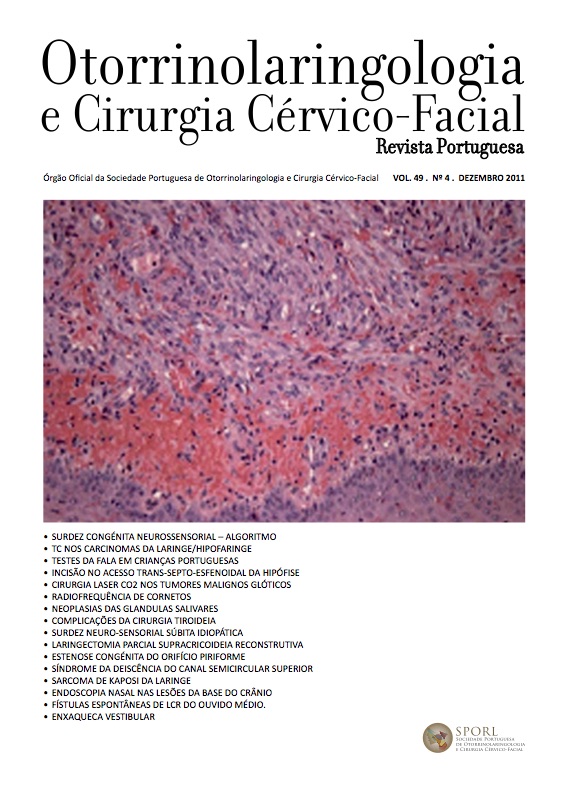Congenital sensorineural hearing loss – Proposal for an investigation algorithm
DOI:
https://doi.org/10.34631/sporl.189Keywords:
algorithm, sensorineural hearing loss, child, guidelinesAbstract
Introduction: The incidence of congenital, moderate to profound sensorineural hearing loss (SNHL) is estimated in 4 per 1000 births. Traditionally, the etiologies of congenital SNHL have been broadly classified as either hereditary or acquired, and it is estimated that up to 50% of moderate to severe cases are genetic in etiology. To date, there is no consensus diagnostic protocol for children presenting with SNHL.
Objectives: This study aims to present a proposal of an investigation algorithm for SNHL in children, based on a review of the literature.
Methods: To develop the algorithm, the English and French literature were searched in PubMed with the following key words: “hearing loss/impairment”, “deafness”, “child”. The guidelines of the British Association of Audiovestibular Physicians and British Association of Paediatricians in Audiology (BAAP/BAPA) and the recommendations of the Spanish Committee for Early Detection of Deafness were also studied.
Results: Children with severe to profound SNHL should first be tested with a GJB2 screen, as opposed to those with milder SNHL, who should undergo CT of the temporal bone as the initial step. Laboratory investigation should not be routine but based on clinical history. Children with unilateral SNHL should be investigated with imaging. The use of ECG is indicated in severe to profound bilateral SNHL to rule out the presence of a prolonged QT interval, because, in spite of an extremely low yield, it can be life-saving.
Conclusions: A stepwise diagnostic paradigm is more efficient and more cost-effective than the simultaneous testing approach.
Downloads
References
Brookhouser P. Sensorineural hearing loss in children. Pediatr Clin North Am 1996;43:1195-216.
Tomaski SM, Grundfast KM. A stepwise approach to the diagnosis and treatment of hereditary hearing loss. Pediatr Clin North Am 1999;46:35-48.
Billings KR, Kenna MA. Causes of pediatric sensorineural hearing loss: yesterday and today. Arch Otolaryngol Head Neck Surg 1999;125:517-21.
Preciado DA, Lawson L, Madden C, et al. Improved Diagnostic Effectiveness with a Sequential Diagnostic Paradigm in Idiopathic Pediatric Sensorineural Hearing Loss. Otol Neurotol 2005; 26:610-615.
Morzaria S, Westerberg BD, Kozak FK. Evidence-Based Algorithm for the Evaluation of a Child with Bilateral Sensorineural Hearing Loss. J Otolaryngol 2005 Oct; 34(5):297-303.
British Association of Audiovestibular Physicians: Guidelines. URL: http://www.baap.org.uk/?q=documents/guidelines (Accessed in 1 Jun.2010)
Trinidad-Ramos G, Aguilar VA, Jaudenes-Casaubón C, Núñez-Batalla F, Sequí-Canet JM. Recomendaciones de la Comisión para la Detección Precoz de la Hipoacusia (CODEPEH) para 2010. Acta Otorrinolaringol Esp 2010; 61(1):69-77.
Morzaria S, Westerberg B, Kozak F. A systematic review of the literature to determine the etiology of bilateral sensorineural hearing loss in children. Int J Pediatr Otorhinolaryngol 2004;68:1193-8.
Kikuchi T, Kimura RS, Paul DS, et al. Gap junctions systems in the mammalian cochlea. Brain Res Rev 2000;82:163-6.
Mafong DD, Shin EJ, Lalwani AK. Use of laboratory evaluation and radiologic imaging in the diagnostic evaluation of children with SNHL. Laryngoscope 2002;112:1-7.
Reilly GP, Lalwani AK, Jackler RK. Congenital anomalies of the inner ear. In: Anil K, Lalwani AK, Grunfast KM, editors. Pediatric otology and neurotology. Philadelphia:Lippincott-Raven; 1998;13:201-10.
Shirazi A, Fenton JE, Fagan PA. Large vestibular aqueduct syndrome and stapes fixation. J Laryngol Otol 1994;108:989-90.
Elmaleh-Bergès M, Van Den Abbeele T. Le sourd est un enfant: qu’est-ce que ça change. J Radiol 2006;87:1795-812.
Paperella MM, Berlinger NT, Oda M, et al. Otological manifestations of leukemia. Laryngoscope 1973;83:1510-26.
Gates G, Cobb JL, D’Agostino RB, et al. The relation of hearing in the eldery to the presence of cardiovascular disease and cardiovascular risk factors. Arch Otolaryngol Head Neck Surg 1993;119:151-61.
Lowry LD, Isaacson SR. Study of 100 patients with bilateral sensorineural hearing loss for lipid abnormalities. Ann Otolaryngol Head Neck Surg 1978;87:404-9.
Fugazzola L, Cerutti N, Mannavola D, et al. Differential diagnosis between Pendred and pseudo-Pendred syndromes: Clinical, radiologic, and molecular studies. Pediatr Res 2001;51:479-84.
Fowler KB, Dahle AJ, Boppana SB, Pass RF. Newborn hearing screening: will children with hearing loss caused by congenital cytomegalovirus infection be missed? Journal of Pediatrics 1999; 135:60-4
Hashiba H. Hereditary QT prolongation syndrome in Japan: genetic analysis and pathological findings of the conducting system. Jpn Circ J 1978;42:1133-50.
Chiang CE, Roden DM. The long QT syndromes: Genetic basis and clinical implications. J Am Coll Cardiol 2000; 36:1-12






